Tran Quoc Pagoda
Located on a small peninsula on the East side of West Lake, Tran Quoc Pagoda is regarded as the most ancient pagoda in Hanoi with its history line of more than 1,500 years.
The architecture of this Buddhist center is a subtle combination between the solemn and beautiful landscape on the peaceful and quiet ambiance of West Lake’s surface. Thanks to these historical and architectural values, Tran Quoc Pagoda attracts many tourists to pay a visit, both inside and outside of Vietnam.
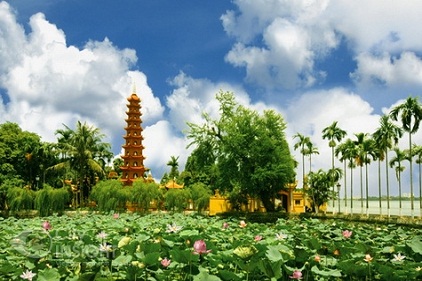
Tran Quoc Pagoda was first erected with the name “Khai Quoc” (Opening a country) during King Ly Nam De Dynasty, between year 544 and 548 on the bark of Red River (approximately within Yen Phu Ward, Tay Ho District now). Till the 15th century, during King Le Thai Tong reign, it was renamed to “An Quoc”, which means a peaceful country.
In 1915, due to a serious landslide ingrained into the pagoda’s foundation that made the incumbent government and people to move the whole construction to Kim Ngư Island on the East of West Lake, and this is Tran Quoc Pagoda’s current location that you can witness in this day and age.
The renaming process didn’t stop until it was changed to the name “Tran Quoc Pagoda”, meaning protecting the country, during King Le Huy Tong dynasty (1681-1705). Through each name of the pagoda, we can see a milestone of the country as well as the wishes of its people attached to this holy sanctuary.
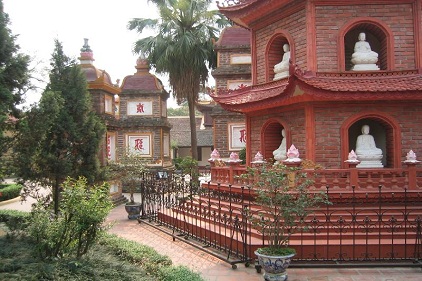
Famous for stunning scenery and sacred sanctuary, Tran Quoc Pagoda used to be a favorite sightseeing place of many kings and lord of Vietnam, especially during festivals, full moon days or Tet. Up until now, the pagoda can still preserve its fame although the landscape has been affected by urbanization.
Besides the front gate facing the crowded Thanh Nien Road, this 3,000m2 complex is surrounded by sliver tide of West Lake, and is designed according to strict rules of Buddhist architecture with many layers of buildings and three main houses called “Tiền Đường”, a house for burning incense and thượng điện. These rooms are connected with each other to form a Công script (工).
.jpg)
The precinct of Tran Quoc Pagoda is highlighted by a high stupa that you may recognize from a far erected in 1998. This stupa is composed of 11 floors with a height of 15m; each floor has a vaulted window holding a statue of Amitabha made from gemstone. On the top stands a nine-storey lotus (Cửu đỉnh liên hoa) and is also gemstone. This stupa is situated symmetrically with the 50-year-old Bodhi tree gifted by former Indian President on the occasion of his visit to Hanoi in 1959. Abbot Thich Thanh Nha of Tran Quoc Pagoda explains the meaning of this correlation: “The lotus represent Buddha while the Bodhi is a symbol of supreme knowledge”.
Not only that, Tran Quoc is also a small museum of priceless antiques dated thousands to hundreds years old like worshiping statues in the front house. These statues are all engraved and polished meticulously by skillful craftsmen, which all bear spectacular features. Among them, the outstanding one is the statue “Thích ca thập niết bàn”, which is evaluated as the most beautiful statue of Vietnam.
With all the historical and architectural values it possesses, Tran Quoc Pagoda is not only worth visiting as a sacred sanctuary of Buddhism attracting countless Buddhist believers; but also an indispensible destination for cultural explorers to Vietnam.
See more
-
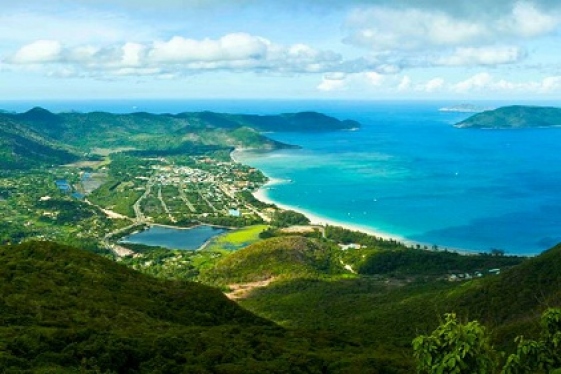
Con Dao National Park
Con Dao is a tourist island and is ranked one of 10 mysterious islands in the world by Lonely Planet. Besides, Con Dao National Park is the 6th Ramsar in the world, and the...
-
.jpg)
Thong Nhat Park
Thong Nhat Park is located next to Hanoi Circus, about 15 minutes by bike to the Old Quarter.
-
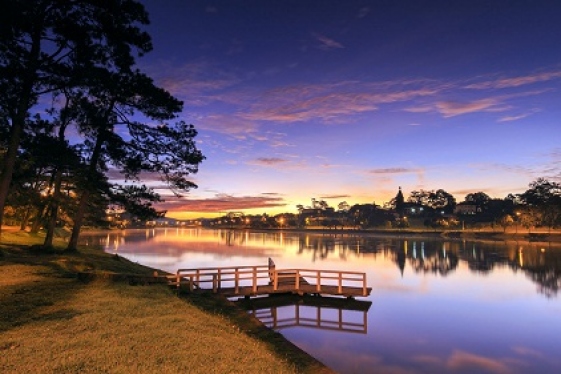
The beautiful Xuan Huong Lake
Xuan Huong Lake is a beautiful lake that located in the center of Dalat . Around the lake, there is a pine forest, lawn and flower garden. So, Xuan Huong lake is a favorite...
-
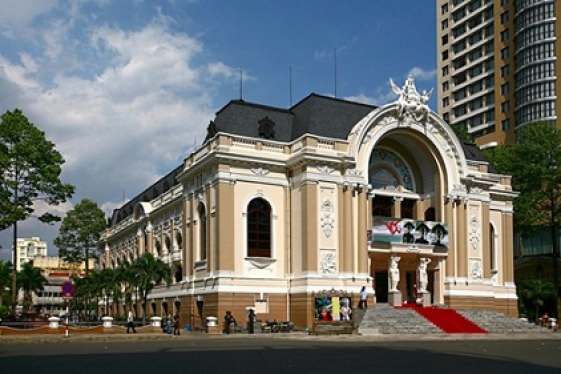
Saigon Opera House
The Saigon Opera House in Ho Chi Minh is an elegant colonial building at the intersection of Le Loi and Dong Khoi Street in District 1, very close to the famous Notre Dame...
-
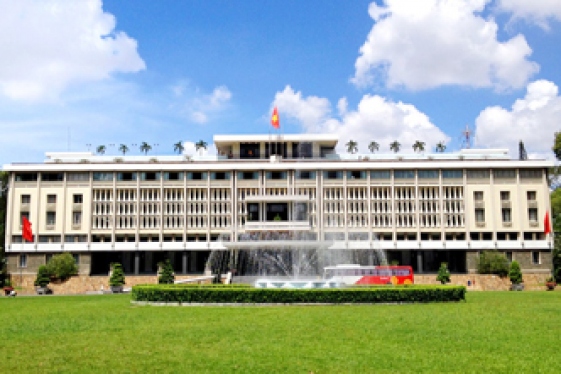
Reunification Palace
Reunification Palace is (known as Independence Palace) the famous historical witness which passed through the two fierce wars against the French and American...
-
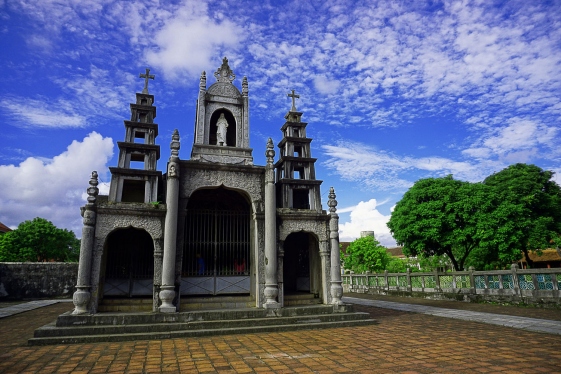
Phat Diem Cathedral
Phat Diem Cathedral is one of the most famous and beautiful churches in Vietnam with special architecture: an elegant combination of Western architectural style and...
-
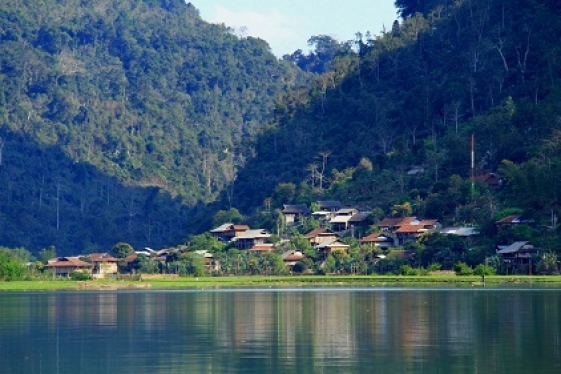
Pac Ngoi Village
Visiting Pac Ngoi village, you not only enjoy the beautiful landscapes of Ba Be lake , forest and mountains but also explore the culture of Tay people. Pac Ngoi village is...
-

Tra Que herb village
For tourists who come from big cities and who are curious about the Asian countryside, Tra Que village in Hoi An i s obviously a good choice. One of the great things about...
-
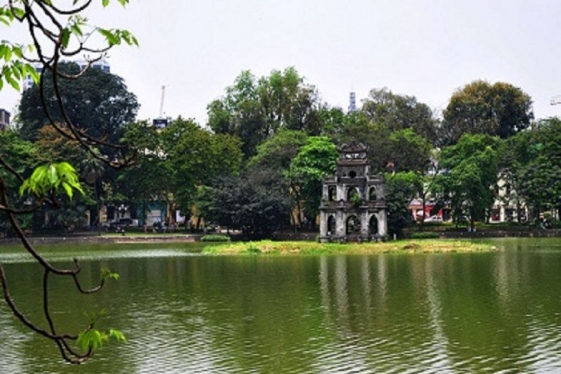
Hoan Kiem Lake & Ngoc Son Temple
There are many beautiful sights in Hanoi but the most attractive sight may be Hoan Kiem Lake. Many people say that “Hoan Kiem Lake is the heart of Hanoi , the...
-

Han River Bridge
Han River Bridge is a symbol for new vitality and the developing desire of Danang and crossing the romantic Han River in Da Nang . Each year, Han River Bridge attracts ,many...
Destinations
Most popular tours
-
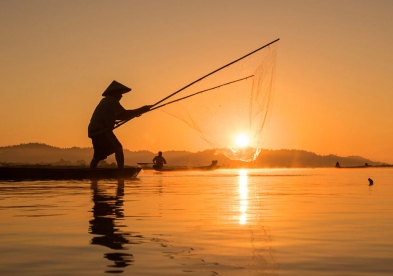
Charm of Vietnam
Price from: 900 US$
-

Sunny Paradise
Price from: 1.510 US$
-

Best of Vietnam
Price from: 1.455 US$
-

Central Coast Vietnam
Price from: 2.014 US$
Business info
Vietnam Local Guide
- Address: 18th Floor, VTC Online Tower, 18 Tam Trinh Str.,Hai Ba Trung Dist., Hanoi, Vietnam
- Email: info@vietnamguider.com
- Phone: (+84) 0904989890
- Hotline: (+84) 0904989890